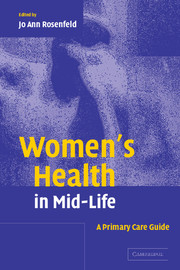Book contents
- Frontmatter
- Contents
- List of contributors
- 1 Introduction
- Part I Health promotion
- 2 Physical activity and exercise
- 3 Nutrition
- 4 Psychosocial health promotion of mid-life women
- 5 Sexual health
- 6 Alcoholism, nicotine dependence, and drug abuse
- 7 Depression and anxiety
- Part II Hormonal changes
- Part III Disease prevention
- Part IV Cancer prevention
- Index
- References
7 - Depression and anxiety
from Part I - Health promotion
Published online by Cambridge University Press: 21 August 2009
- Frontmatter
- Contents
- List of contributors
- 1 Introduction
- Part I Health promotion
- 2 Physical activity and exercise
- 3 Nutrition
- 4 Psychosocial health promotion of mid-life women
- 5 Sexual health
- 6 Alcoholism, nicotine dependence, and drug abuse
- 7 Depression and anxiety
- Part II Hormonal changes
- Part III Disease prevention
- Part IV Cancer prevention
- Index
- References
Summary
Case: “I am turning into a big fat lump that just lies around eating, sleeping and feeling sorry for myself all the time!” This sudden outburst during a visit for a “routine pap smear” is completely out of character for Marie, a 44-year-old divorced schoolteacher who is usually smartly groomed, articulate, and vivacious. Tactful questioning reveals about a four-week history of excessive sleeping and feelings of fatigue, low stamina, and worthlessness. She has been snacking excessively and has gained about six pounds. Marie admits to severe “blues” during her freshman college year and after the births of her children, but she “toughed it out.” This time, she does not have the energy or will to continue her daily activities and she has called in sick for the first time ever as she “just could not face doing a mediocre job for the class.”
Introduction and epidemiology
Up to 30% of women seen in primary care clinics suffer from a depressive illness, compared with an estimated 19% of male patients. In the general population, approximately one-quarter of all women but only 10% of men suffer from depression at any time during the lifespan. This gender difference begins in adolescence and continues until the sixth decade. As individuals, women generally carry a greater burden of illness in depression than men. Depression is more likely to begin at an earlier age in women and to follow a pattern with more severe, chronic, and recurrent illness with greater functional impairment and more comorbid conditions than in male patients.
Keywords
- Type
- Chapter
- Information
- Women's Health in Mid-LifeA Primary Care Guide, pp. 97 - 122Publisher: Cambridge University PressPrint publication year: 2004
References
- 1
- Cited by



